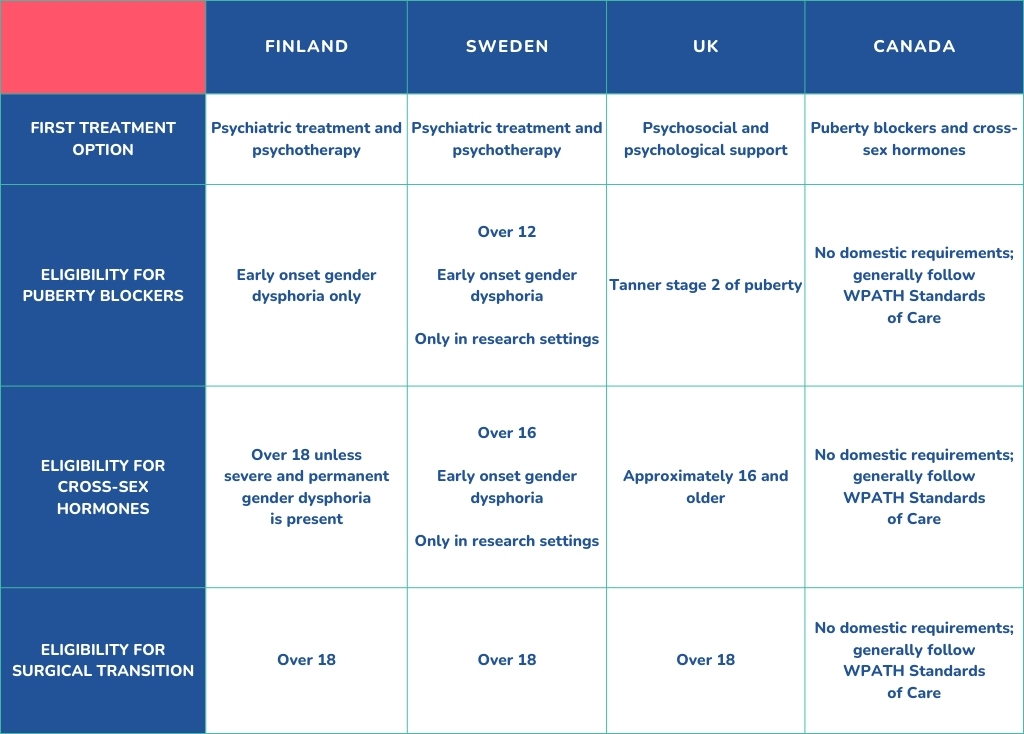The goal of Let Kids Be is to ban medical and surgical transitioning for minors. Many Canadians think that this is a radical proposal. That it is an attack on trans rights. But is it?
In short, no. Many developed jurisdictions, both progressive and conservative alike, have begun to realize the problems presented in previous articles and are greatly restricting medical and surgical transitioning.
In 2020, the Finnish Health Authority broke with the prevailing gender-affirming model of care which rushes children and adolescents into medical and surgical treatments. Instead, psychiatric treatment and psychotherapy are once again the first steps prescribed to address gender dysphoria. Cross-sex hormones are generally available only to persons over the age of 18. Surgical treatments are not considered treatment methods for dysphoria in minors. The Finnish Health Authority also warns against any irreversible gender-affirming interventions for those below the age of 25, due to a lack of neurological maturity.1
In Finland, surgical treatments are not considered treatment methods for dysphoria in minors.
In 2021, Astrid Lindgren Children’s hospital in Sweden decided not to provide puberty blockers or cross-sex hormones to persons under the age of 16. For those aged 16-18, hormonal treatments would only be offered within clinical trials.2
In 2022, the Swedish National Board of Health and Welfare reformed their standards of care across the board, following Finland’s approach of making psychological and psychiatric care the first treatment option for all minors. They will allow cross-sex hormones only for people with early-onset gender dysphoria and at a minimum age of 16.3
In 2022, the United Kingdom’s sole child gender identity clinic in Tavistock was closed in favour of a decentralized regional hub model following the release of the Cass Report, an interim report that studied the treatment of gender dysphoria in the United Kingdom. Although the report made no definitive recommendations, it did find that “an unquestioning affirmative approach is at odds with the standard process of clinical assessment and diagnosis that they have been trained to undertake in all other clinical encounters” and that greater safeguards, such as a formal diagnosis of gender dysphoria prior to hormonal treatment, was necessary.4
In 2023, the UK’s National Health Service issued new interim guidance, reminding clinicians that “this may be a transient phase, particularly for pre-pubertal children,” that a “significant proportion of children and young people who are concerned about, or distressed by, issues of gender dysphoria experience coexisting mental health, neuro-developmental and/or personal, family or social complexities in their lives,” and that there are “risks of an inappropriate gender transition.” The primary intervention is now psychosocial and psychological support.5
A growing refrain from these national reviews is that there is a lack of evidence to support these medical and surgical interventions, particularly in the long-term.
In 2022, the National Academy of Medicine in France released a statement urging medical practitioners to use the “greatest caution” when prescribing puberty blockers or cross-sex hormones, given “the side-effects such as the impact on growth, bone weakening, risk of sterility, emotional and intellectual consequences and, for girls, menopause-like symptoms.”6
In 2023, the Norwegian Healthcare Investigation Board also found their national professional guidelines to be too loose and overly biased in favour of hormonal and surgical interventions. Like the United Kingdom in the Cass Report, Norway will be re-drafting its guidance on gender-affirming care.7
Finally, a growing number of American states (21 as of December 2023) have introduced, debated, and passed laws that ban the provision of puberty blockers, cross-sex hormones, and/or gender reassignment surgery to minors.8
A growing refrain from these national reviews is that there is a lack of evidence to support these medical and surgical interventions, particularly in the long-term. It is clear that these interventions are still experimental at best, with a growing body of evidence suggesting they do profound harm with no benefit to the patient.

Canada must follow suit.
Canada’s current gender-affirming approach to gender dysphoria must be abandoned in favour of body-affirming care. If there is a perceived dysphoria between a person’s biological sex and their gender identity, health care practitioners should understand that trying to change biological sex is far more risky, difficult, and invasive than psychiatric treatment and psychotherapy that seek to change self-perception. Fundamentally, biological sex cannot change but the self-perception of the psychological, social, and cultural aspects of being male and female can change. This is why psychiatric treatment and psychotherapy are becoming the first treatment method of choice for countries such as Finland and Sweden.
Unfortunately, pursuing these alternatives to gender-affirming care is risky for anyone within or even outside of health care due to various federal and provincial bans on conversion therapy. The poorly written federal conversion therapy legislation bans “any practice, treatment or service designed to… change or repress a person’s gender identity to cisgender or… change, repress, or reduce a person’s gender expression so that it conforms to the sex assigned to the person at birth.”9 This legislation effectively shuts the door to body-affirming care and leaves gender-affirming care as the only legally permissible treatment for gender dysphoria.
Fundamentally, biological sex cannot change but the self-perception of the psychological, social, and cultural aspects of being male and female can change.
Addressing gender dysphoria must be a holistic, multifaceted process. Gender dysphoria – the psychological distress caused by a perceived incongruence between one’s biological sex and perceived gender – must be alleviated. Any comorbidities must be diagnosed and treated. The religious and cultural beliefs of the patient as well as their parents must be respected. The influence of peer groups on gender identity must be understood and countered, if required. The negative impacts of social media and web consumption must also be counteracted.
Gender dysphoria is not something that is easily solved by hormones or surgery. It is far more complicated than that.10
While there are all sorts of policies that our government can implement in Canada in response to this issue, the most urgent one is to stop the practice associated with the greatest harm: medical and surgical transitioning for minors. We call upon Canada’s provincial governments to prohibit the provision of puberty blockers, cross-sex hormones, and gender reassignment surgeries for minors.
Will you join us?
- Society for Evidence Based Gender Medicine, “One Year Since Finland Broke with WPATH Standards of Care,” July 2, 2021, https://segm.org/Finland_deviates_from_WPATH_prioritizing_psychotherapy_no_surgery_for_minors. ↩︎
- Society for Evidence Based Gender Medicine, “Sweden’s Karolinska Ends All Use of Puberty Blockers and Cross-Sex Hormones for Minors Outside of Clinical Studies,” May 5, 2021, https://segm.org/Sweden_ends_use_of_Dutch_protocol. ↩︎
- Society for Evidence Based Gender Medicine, “Summary of Key Recommendations from the Swedish National Board of Health and Welfare,” February 27, 2022, https://segm.org/segm-summary-sweden-prioritizes-therapy-curbs-hormones-for-gender-dysphoric-youth. ↩︎
- Cass, “Interim Report – Cass Review.” ↩︎
- NHS England, “Interim Specialist Service for Children and Young People with Gender Incongruence,” June 9, 2023, https://www.england.nhs.uk/wp-content/uploads/2023/06/Interim-service-specification-for-Specialist-Gender-Incongruence-Services-for-Children-and-Young-People.pdf. ↩︎
- French National Academy of Medicine, “Medicine and Gender Transidentity in Children and Adolescents,” February 25, 2022, https://www.academie-medecine.fr/la-medecine-face-a-la-transidentite-de-genre-chez-les-enfants-et-les-adolescents/?lang=en. ↩︎
- National Commission of Inquiry for the Health and Care Service, “Patient Safety for Children and Young People with Gender Incongruence,” Ukom, March 9, 2023, https://ukom.no/rapporter/pasientsikkerhet-for-barn-og-unge-med-kjonnsinkongruens/sammendrag. ↩︎
- Although we profoundly disagree with their framing of this issue, the Human Rights Campaign has an informative map of which states have banned some form of gender-affirming care that is regularly updated: https://www.hrc.org/resources/attacks-on-gender-affirming-care-by-state-map ↩︎
- Section 320.101, Criminal Code of Canada. ↩︎
- Bailey and Blanchard, “Gender Dysphoria Is Not One Thing.” ↩︎
